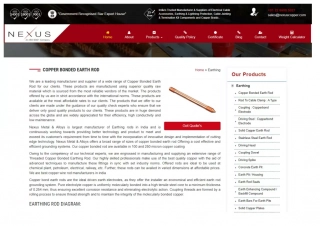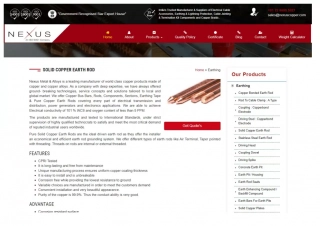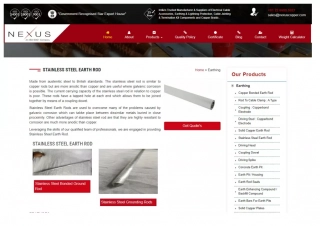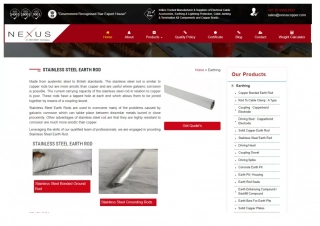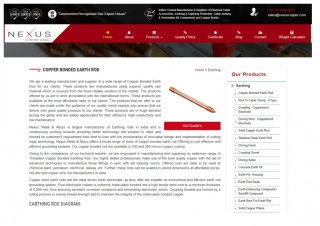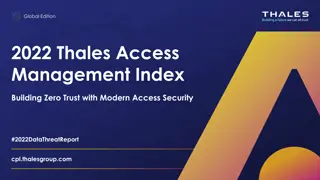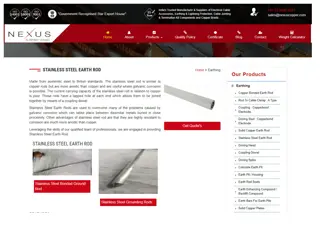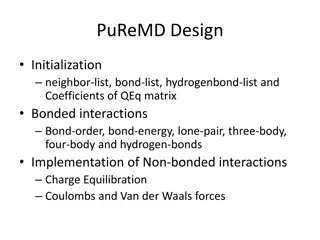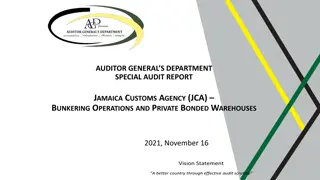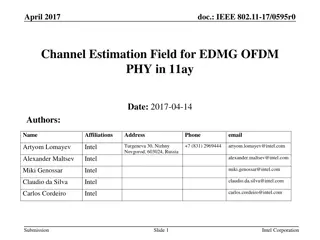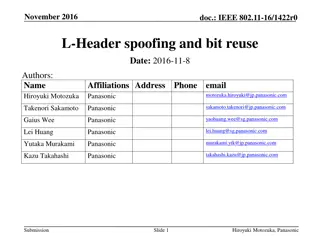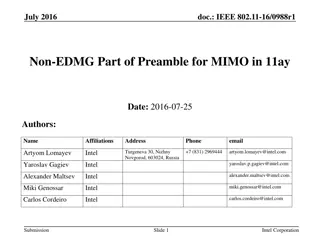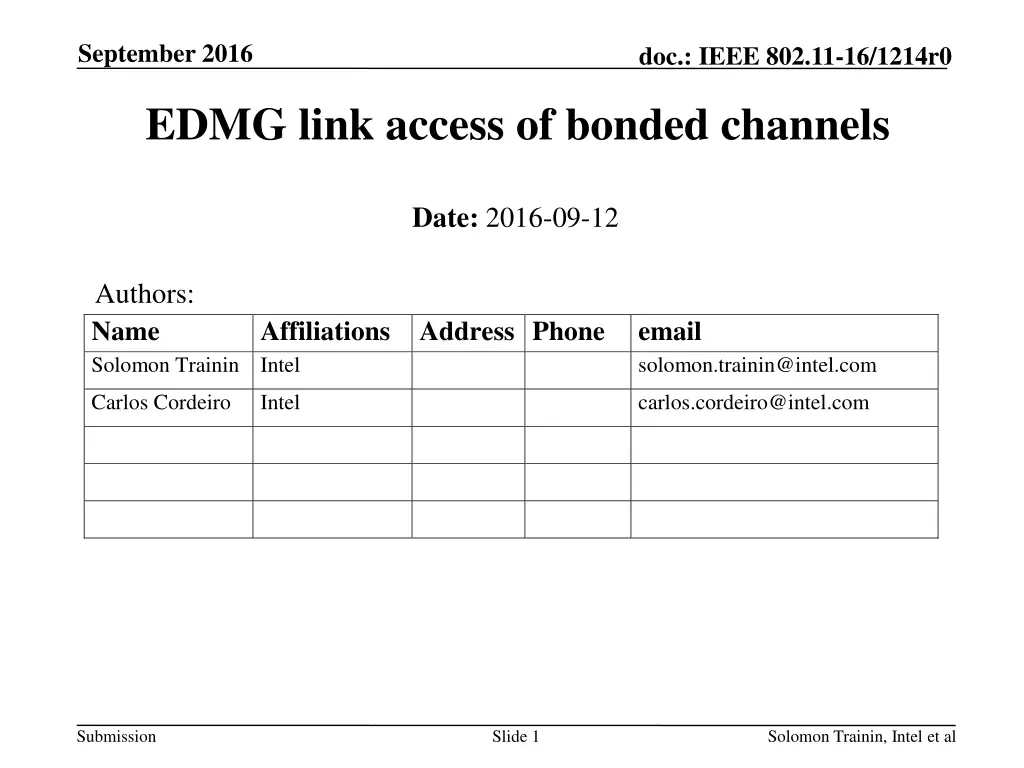
IEEE 802.11-16/1214r0 EDMG Link Access of Bonded Channels
This document presented in September 2016 covers the IEEE 802.11-16/1214r0 standard relating to link access for bonded channels. It delves into MAC-specific details, basic principles, and transmission sequences across multiple channels, providing insights and solutions for contiguous channel bonding and channel aggregation scenarios.
Download Presentation

Please find below an Image/Link to download the presentation.
The content on the website is provided AS IS for your information and personal use only. It may not be sold, licensed, or shared on other websites without obtaining consent from the author. If you encounter any issues during the download, it is possible that the publisher has removed the file from their server.
You are allowed to download the files provided on this website for personal or commercial use, subject to the condition that they are used lawfully. All files are the property of their respective owners.
The content on the website is provided AS IS for your information and personal use only. It may not be sold, licensed, or shared on other websites without obtaining consent from the author.
E N D
Presentation Transcript
September 2016 doc.: IEEE 802.11-16/1214r0 EDMG link access of bonded channels Date: 2016-09-12 Authors: Name Solomon Trainin Intel Affiliations Address Phone email solomon.trainin@intel.com Carlos Cordeiro Intel carlos.cordeiro@intel.com Submission Slide 1 Solomon Trainin, Intel et al
September 2016 doc.: IEEE 802.11-16/1214r0 Abstract Link access for bonded channels Submission Slide 2 Solomon Trainin, Intel et al
September 2016 doc.: IEEE 802.11-16/1214r0 Purpose and definitions Purpose of this presentation is to provide more MAC specific details in relation to CBAP in multiple channels Submission Slide 3 Solomon Trainin, Intel et al
September 2016 doc.: IEEE 802.11-16/1214r0 Basic principles Two types of multiple channels: Contiguous channel bonding of two or more adjacent channels Channel aggregation Proposed solutions are applicable for both types of multiple channels Submission Slide 4 Solomon Trainin, Intel et al
September 2016 doc.: IEEE 802.11-16/1214r0 Tx Sequence in multiple channels NAV setup Mixed mode preamble and header ACK/BA wideband vs. duplicated Tx Sequence in multiple channels BW allocation from 2016-TECH-Intel-0031-01- NG60 channel bonding more details r1 CH1 P R T S T r l STA A CH1 P Data C T S T r l STA B R T S T r l STA A STA B CH2 C T S T r l NAV STA C CH2 Duplicated RTS/CTS allows STA C to set up NAV ACK/BA wideband versus duplicated Submission Slide 5 Solomon Trainin, Intel et al
September 2016 doc.: IEEE 802.11-16/1214r0 Tx Sequence in multiple channels BW allocation R T S T r l Data STA A CH1 P C T S T r l STA B ACK /BA Tx Sequence in multiple channels BW allocation from 2016-TECH-Intel-0031-01- NG60 channel bonding more details r1 CCA busy is indicated by STA A CH2 STA A STA B CH2 CH1 P STA C STA A decides not to use secondary channel due to CCA busy and still use primary channel to utilize opportunity to deliver data RTS/CTS provides BW indication Energy is detected by STA A in Secondary channel TXOP initiator is able to change Tx BW at the time it issues RTS in response to conditions changes TXOP responder is able to receive frame sent not in full BW Submission Slide 6 Solomon Trainin, Intel et al
September 2016 doc.: IEEE 802.11-16/1214r0 No use of primary channel Introduces substantial complication in CBAP with multiple accesses (CBAP only=1, both AID = broadcast) Since full carrier sense is required on primary channel only, this approach can cause excessive unfairness and interferences even in the same BSS as not all STAs in the BSS may be aware of such access when trying to access the channel Submission Slide 7 Solomon Trainin, Intel et al
September 2016 doc.: IEEE 802.11-16/1214r0 Straw polls Do you agree to insert the following sentence in section 3.1.2 of the SFD "A TXOP responder shall be able to receive a frame sent on a channel that does not include all secondary channel(s) Do you agree to insert the following sentence in section 3.1.2 of the SFD "Multiple channel access in the DTI shall include the primary channel if the CBAP Only subfield in the DMG Parameters field is set to 1" Do you agree to insert the following sentence in section 3.1.2 of the SFD "Multiple channel access in the DTI shall include the primary channel if both source and destination AID fields of an allocated CBAP are equal to broadcast" Submission Slide 8 Solomon Trainin, Intel et al
September 2016 doc.: IEEE 802.11-16/1214r0 Straw polls Do you agree to insert the following sentence in section 3.1.2 of the SFD "At least CCA of energy detection shall be performed on each non-primary channel Do you agree to insert the following sentence in section 3.1.2 of the SFD "A TXOP initiator shall not use a secondary channel if CCA of the channel is busy and may use the channel otherwise" Submission Slide 9 Solomon Trainin, Intel et al
September 2016 doc.: IEEE 802.11-16/1214r0 References Submission Slide 10 Solomon Trainin, Intel et al

